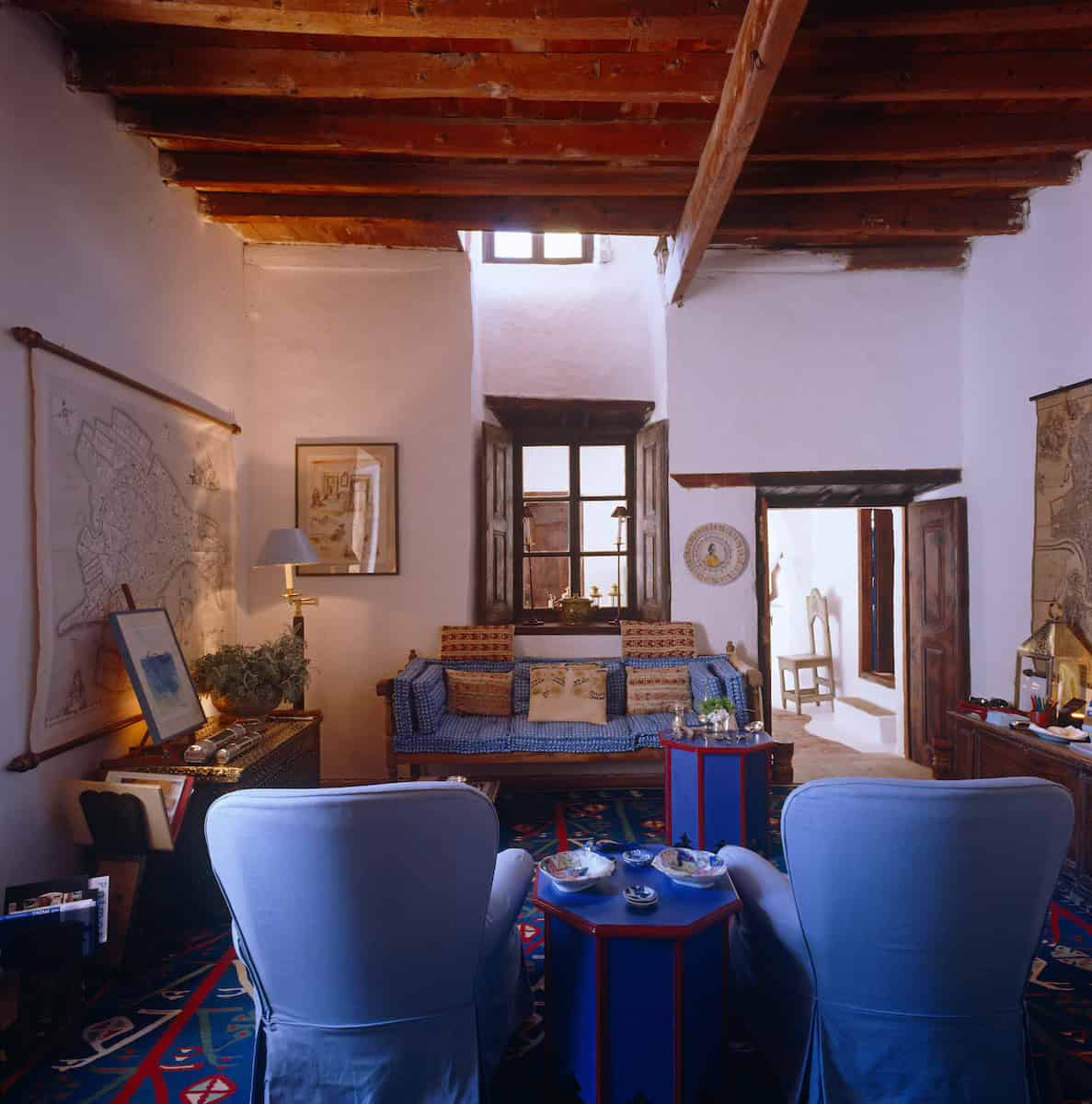John Stefanidis.
For the London-based designer, an island-hopping tour of Greece turned into a life-long love for the magic of Patmos.
Some years ago, John Stefanidis was interviewed for BBC Radio’s Desert Island Discs. Recounting a series of storied life moments, he described his ideal castaway scenario in between fragments of the music he would take with him, from Maria Callas and Egyptian legend Umm Kulthum to the Italian pop artist, Ornella Vanoni. He spoke with authority as, in a way, he’d already done the deserted-island thing.
“I took a trip to the Greek Islands with an Italian friend in the summer of 1963,” he told me over the phone during the Covid lockdown. “We were on somebody’s beautiful yacht but we were so bored, we sent ourselves a telegram to say that there was an emergency and we had to leave.”


A plan was hatched to meet their artist friend, Teddy Millington-Drake on Mykonos, after which Stefanidis and Millington-Drake island-hopped their way to Rhodes and then, following 18 hours on an old boat laden with animals, landed on Patmos.
The hilltop town of Chora has been a UNESCO World Heritage site since 1999, but on the day Stefanidis and Millington-Drake set out from the harbour in search of food and lodgings, its labyrinth of streets and crumbling houses was still largely abandoned. Seeing only potential – Stefanidis later described Chora as possessing the beauty of a de Chirico painting – by the end of that first summer on Patmos, the pair were negotiating to buy a 17th-century farmhouse terracing down the hill, just below the ramparts of St John’s monastery.

While it seems natural that someone with such a Greek surname should buy a house in Greece, Stefanidis was born in Egypt. “I’m what’s called an Alexandrine Greek, as my family came from Alexandria,” he says. “It’s quite different. In those days Alexandria was a truly Mediterranean city, very cosmopolitan. Racism was completely alien — it was taken for granted that people were of different backgrounds.”
Born in Cairo in 1937, Stefanidis lived for a time with his parents in Eritrea. At eight, he was sent back to the Egyptian capital to live with his aunt and uncle and attend school. “They were extremely affectionate and very cultivated,” says Stefanidis. “I remember wanting to go to the movies but my uncle would instead drag me to the Cairo Museum. I did enjoy those visits but there was no alternative, if you see what I mean.”
He was soon enthralled by the history and culture of the city and what he would later describe as “the transformative power of light” — a seminal experience in his development as an aesthete. In 1955, he moved to England to attend Oxford, graduating with a degree in modern languages. “I then worked in advertising for five years in Milan,” says Stefanidis. “I knew after three years that it wasn’t for me.”



Stefanidis returned to Patmos over the winter to commence restoration of the farmhouse in Chora, working with Thomas Ypsilantis, “the one good builder on the island”. Cascading down over three levels, the house had been derelict for 25 years but its bones were essentially good, with carved doors, bleached wooden floors and a double-vaulted private chapel dedicated to St George and St Eustace at the bottom of the garden. Buttressed walls were patched and whitewashed, a storeroom was given a window and a local stonemason used pebbles from a nearby beach to craft a sea serpent mosaic in the floor of what is now the Lemon Terrace. Inside, furniture and architectural mouldings were painted cerulean blue. (Another outdoor room came to be known as the Freya Stark Terrace, named after the scholar and travel writer who would work on the terrace each morning before heading to the beach for a swim.)
Other additions and improvements were carried out over the years. A house was purchased to create guest quarters in 1966, and additional land to extend the garden, now filled with cypress, olive and citrus trees. The home’s vernacular structure, though, has not been altered. “My philosophy for houses is that they must keep their integrity,” says Stefanidis. “Most of it is 17th century. I wanted to make it comfortable but change as little as possible.”
The summer of 1964 was the first spent under the newly restored roof. Captivated by the “clarity of Greece” much as he’d been by the ancient wonder of Egypt years before, Stefanidis quit Milan for Athens soon afterwards. The renovation had unleashed his flair for crafting beautiful homes and in 1967, he established his architecture and interior design practice in London. Clients have included the Bank of England, Claridges, and the Duke and Duchess of Westminster, not to mention a dozen or so other houses for friends and clients on Patmos.
There has also been the design of furniture, such as the Malcontenta chair, found in cerulean in the sitting room and around a table on the breakfast terrace in Pompeii red. More recently his fabrics were used to decorate the exclusive London club, 5 Hertford Street.
His friend Susanna Moore co-authored Stefanidis’ 2010 book, An Island Sanctuary, which is dedicated to his house in Greece. “I never want to be with anyone but John,” she says, “and never any place but in his house in Chora.” It would certainly be difficult to find a home more emblematic of the Mediterranean and all the cross-cultural wonder it represents. The same, of course, can be said about the cosmopolitan Stefanidis.
From a story originally published in Vogue Living.

The long awaited monograph, John Stefanidis – A Designer’s Eye is available from Rizzoli.